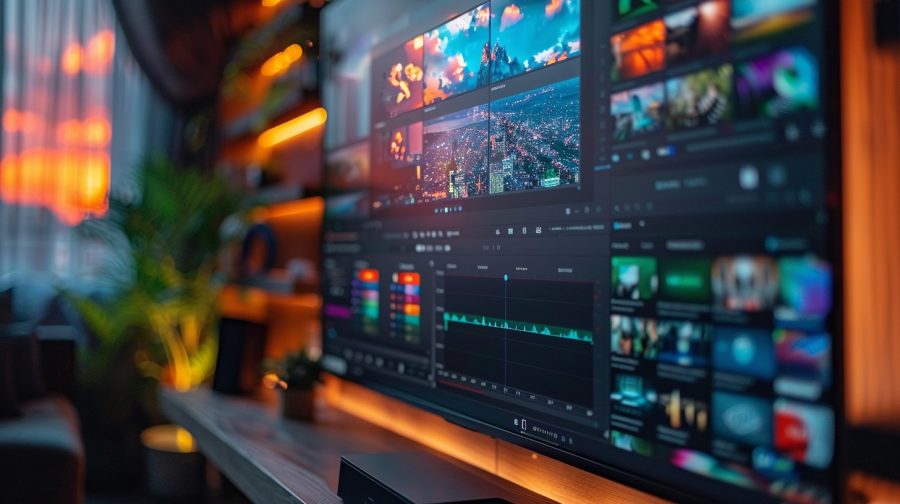In the rapidly evolving home entertainment landscape, AI has become a pivotal element in transforming Smart TVs into dynamic, interactive, and highly personalized hubs, extending their role beyond mere content consumption. AI technologies integrated into Smart TVs elevate every facet of the viewer’s experience. This includes optimizing picture and sound quality to match specific content and viewing conditions, offering voice-controlled operations, and providing tailored content recommendations.
The Smart TV App development plays a crucial role in enhancing these features by allowing users to access a wide range of applications and services. These intelligent systems also enable Smart TVs to act as central command centers for smart home devices, enhance audio for immersive experiences, upscale content to higher resolutions, and adjust settings for energy efficiency.
Enhanced picture quality
Modern Smart TVs leverage AI engines to significantly improve visual output. These systems analyze images in real-time to optimize settings such as color saturation, sharpness, and contrast for each scene. For example, AI can detect dark scenes in a movie and adjust brightness to reveal details without compromising the image. This dynamic adaptation ensures viewers enjoy cinematic-quality visuals irrespective of the genre or format.
Example: The Samsung QLED TV series showcases this with its AI-powered Quantum Processor 4K, which intelligently upscales content to 4K resolution. This processor adjusts brightness and sound according to room conditions and content, ensuring detailed and lifelike images whether watching a dark, gritty thriller or a vibrant animated film.

Voice control and interaction
AI-powered voice control stands out as a highly convenient feature of Smart TVs. With advanced natural language processing, these TVs can understand and execute a wide range of voice commands. This technology goes beyond basic functions like channel switching; it can answer weather questions, control playback in streaming apps, or even order food from local services without interrupting your viewing.
Integration with virtual assistants like Alexa or Google Assistant further expands functionality, making Smart TVs a key element in the voice-controlled ecosystem of modern homes. To explore the new features and learn how smart TV apps are developed, we recommend studying this guide.
Example: LG’s ThinQ AI technology exemplifies this, where the LG Magic Remote allows users to control their TV using natural language commands. This system integrates with Google Assistant and Amazon Alexa, enabling users to search for content and manage other smart home devices through voice commands.
Content recommendation
AI-driven content recommendation systems employ sophisticated algorithms to analyze viewing patterns and search histories to suggest relevant content. These systems learn from user interactions to better align suggestions with personal preferences, ensuring users spend less time searching and more time enjoying content they genuinely like, thereby enhancing user satisfaction and loyalty.
Example: Netflix’s recommendation system on Smart TVs serves as a prime example. It uses AI to analyze your previous viewing habits to suggest new shows and movies you’re likely to enjoy. This personalized recommendation engine keeps users engaged, reducing churn rates and improving overall user experience.

Smart home integration
With seamless integration into IoT ecosystems, TVs can now display security camera feeds, control lighting, manage thermostats, and even sync with smart refrigerators to show grocery lists or reminders. This comprehensive approach streamlines device management and enhances the TV’s role in the household, positioning it as a central hub for home automation.
Example: The Sony Bravia Smart TV effortlessly integrates with other smart devices through Google Home, allowing users to access various IoT functions directly from their TV. For instance, you can view your front door camera feed, adjust room lighting, and set the thermostat, all without leaving your couch.
Adaptive sound systems
AI-enhanced Smart TVs can customize audio output based on content type and ambient conditions. For example, during an action movie, the AI might boost bass levels for impactful explosions or clarify dialogue in a drama. Sound adaptation extends beyond content type, considering room acoustics to mitigate echo and optimize clarity, ensuring an excellent auditory experience from every seat.
Example: Samsung’s Q-Symphony technology synchronizes TV speakers with soundbars to adapt audio based on the media being played. During a live concert broadcast, for example, the system enhances acoustics to replicate the ambiance of a concert hall, delivering a richer, more immersive audio experience.




